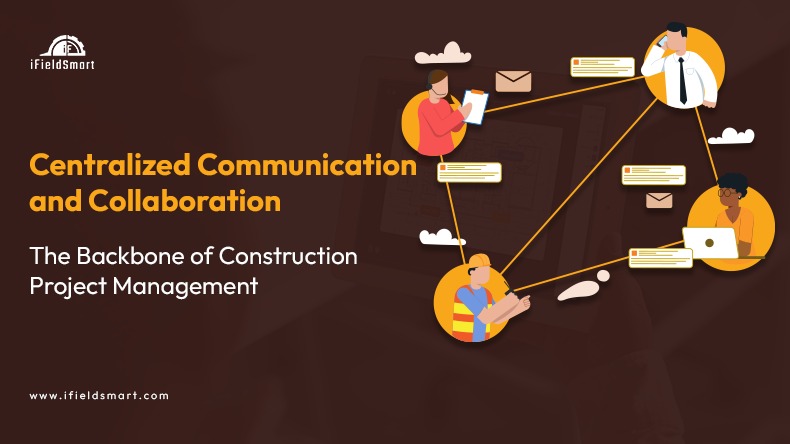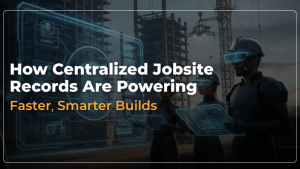Reading Time: 5 minutes
Introduction
Seamless communication and collaboration improve project execution. The complex nature of construction, which includes various stakeholders, intricate workflows, and condensed timelines, requires a unified strategy. In this premise, construction management software is a crucial platform as it is a digital tool that helps with faster information channeling between various participants.
Leveraging the power of unification
Construction project management software is a unified tool that connects every project-driven documentation. By removing data silos and providing a collaborative capability, these platforms connect participants and promote clarity at multiple project phases. Let’s understand the advantages that are offered.
Listed benefits include:
- Quick and real-time data sharing: Construction project management apps support various teams with real-time data updates on multiple facets, including schedules, tasks, and project tracking. Dynamic data flow removes ambiguities and helps every project stakeholder stay informed, even from remote locations.
- Enhanced document management: Unified data storage for various deliverables includes plans, documents, permits, and other crucial records that ensure every team accesses the most updated file versions. Seamless document management reduces issues that originate from outdated data and mitigates costly rework, which improves efficiency.
- Efficient task assignment and monitoring: Project managers can leverage these digital tools to achieve task assignments, timeline setting, and progress tracking. This strategy ensures every task moves according to planned timelines and sticks with required project standards. Proactively monitoring tasks and issues helps teams preemptively resolve them.
- Robust issue resolution: The capacity to create, assign, and monitor issue resolution facilitates faster problem-solving. Cutting issues during the preconstruction phase helps project teams prevent costly delays and hand over projects within planned schedules.
Exploring the Top 5 Construction Project Management Software
Working with the right construction management software requires stringent considerations of unique project requirements and the complexities encapsulated within them. Here’s a snapshot of these solutions:
Work Smarter, Not Harder
iFieldSmart empowers your team with AI-driven efficiency to simplify scheduling, boost collaboration, and keep projects on track.
Schedule a Meeting- Procore: A digital tool that is used for a plethora of capabilities which includes project management, safety and quality management, financial dashboards, and other features. Its features are built for diverse project needs and people at different scales.
- Autodesk Construction Cloud: An integrated and powerful construction management tool for end-to-end use including planning, design, construction, and operations. Leveraging seamless communication and collaboration across various phases improves effectiveness and eliminates data gaps.
- PlanGrid: Streamlined document management enriched with capabilities like field collaboration through faster mobile access and markup capabilities makes PlanGrid a powerful tool. A user-friendly dashboard helps teams with quick document collaboration on the fly.
- iFieldSmart Technologies: It is a powerful and versatile tool that is built with capabilities for document sharing, task management, time monitoring, and communication in real time. A better adaptability algorithm makes it a preferred choice for various construction projects that encourage seamless workflows.
- Fieldwire: Built with a strong focus on collaboration in the field, this digital tool provides capabilities for task management, viewing plans, and issue monitoring, which helps team communication and collaboration in real time.
One of the most versatile solutions for construction management: iFieldSmart.ai
iFieldSmart.ai has proved itself as one of the most powerful solutions for construction project management. Built with user-friendly dashboards and a comprehensive set of features, its use helps stakeholders work as a diverse platform for construction projects. Its key capabilities include:
- Enhanced task management is driven by accuracy and efficiency: Efficient task management which includes creation to handover, assigning teams with responsibilities, setting timelines, and tracking real-time progress. Comprehensive task management helps projects align with set timelines.
- Facilitating real-time communication and collaboration: Drive streamlined collaboration between teams based on instant messaging and quick notifications. Interaction in real-time drives faster problem resolution and improves coordination.
- Faster and secure document sharing: Storage and sharing of crucial project files, which ensures every stakeholder has complete access to the most updated dataset. The use of a unified document storage system reduces ambiguities and encourages faster decision-making.
- In-depth time tracking and insights to achieve greater productivity: Track project progress and cost of labor with higher accuracy for time tracking. These powerful insights can help project management teams improve resource allocation and optimize project impact.
Artificial Intelligence and Machine Learning AI & ML: Advanced tools to achieve optimized unification
Artificial Intelligence and Machine Learning AI and ML are changing how construction management software unifies team communication and collaboration. These capabilities get predictive analysis, smart automation, and information-based insights to the frontline, which helps teams with faster interactions and decision-making.
Top 4 advantages enhanced by AI & ML
- Predictive analytics built for preemptive decision-making: AI-fuelled analytics uses historical data to forecast risks, and schedule and cost overruns. This helps project managers with informed decision-making while resolving problems before they manifest on-site.
- Smart automation leading to streamlined workflows: Machine Learning (ML) workflows and algorithms can help with task automation for tasks including document routing, data entry, and creation of reports. This can help stakeholders leverage crucial time to focus on strategic tasks and complexities in problem-solving.
- Data-driven insights used for improved performance: Construction project management apps reinforced with Artificial Intelligence and Machine Learning can help assess vast data sets to analyze trends and patterns. These important insights improve resource allocation, and scheduling, and improve performance.
- Natural language processing leading to streamlined communication: Natural language processing helps with intuitive and natural data interactions within project management tools. Capabilities like chatbots, voice commands, and sentiment assessment streamline communication and foster team collaboration.
Heading to a strong conclusion
The capacity to unify communication and collaboration is an important feature of construction project management software. Providing a centralized digital tool that fosters data sharing, document management, and task monitoring helps teams operate at higher efficiency, eliminates errors, and helps with faster project handovers.
While selecting the required construction project management software, these tools must align with unique project needs and complexities. Using these capabilities with software like iFieldSmart.ai would help you leverage centralized collaboration for greater project impact and success.








